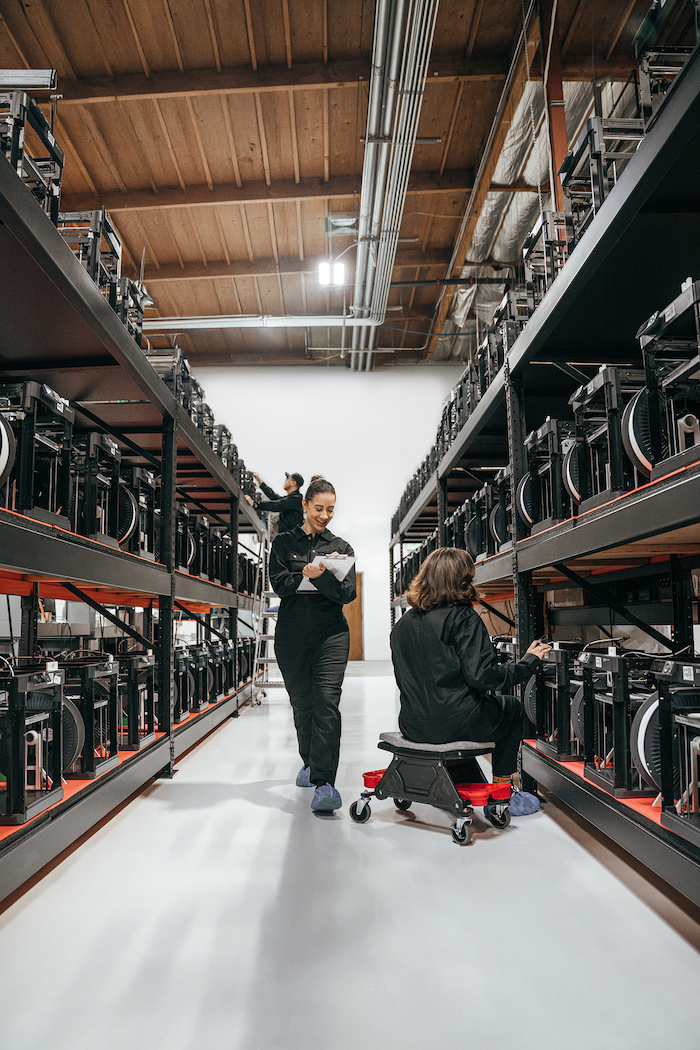In a tucked-away San Francisco Bay Area suburb, Gantri has an unusual lighting factory. It spans 30,000 square feet, but runs with a lean staff of 20. Instead of screeching CNC machines and whirring polishing wheels, the warehouse is filled with robotics systems and rows of 3D printers—over 1,000 of them—humming away in sync. The company’s production system, built by Gantri founder Ian Yang, relies on software to coordinate the machines to produce lighting fixtures, mostly designed by buzzy independent studios. Now Yang is opening up Gantri’s doors: Anyone can produce a line there—maybe even you.
The program, called Gantri Made, officially launches this month. In concept, it’s not so different from working with any factory or workshop: Customers submit schematics, receive a prototype and fine-tune it, and then the design goes into production. However, Yang says Gantri Made can go from a concept to a UL-certified, market-ready product in as little as three months, for an engineering startup cost as low as $10,000—an order of magnitude faster and cheaper than traditional manufacturing.
“If you think about the typical production development process, you spend a ton of time. You have to buy a batch of inventory and store it in a warehouse,” says Yang. “[Our system] just takes all that away. It makes it easier for smaller brands, for larger brands, and it's very flexible. The purpose is to lower the barriers to creativity.”

Gantri is the product of Yang’s varied career and interests. As a child, he watched his parents build a business exporting goods from China to the U.S. and picked up a feel for manufacturing along the way. While attending university in England, he honed an appreciation for art and design, after which he moved to San Francisco, learned to code and dove into the tech scene. He describes Gantri as a weaving together of the three chapters of his life: manufacturing, design and technology.
The brand was launched in 2015 with investment from his family as well as outside family offices. Yang spent five years tweaking the manufacturing system before opening the brand’s current factory in 2020. Releasing collections by designers and studios ranging from Ammunition to Karim Rashid, Gantri has mostly sold DTC (prices go from roughly $200 to $500), though more recently it has done business through the MoMA Design Store.
A digitally orchestrated, 3D printing–driven production process has given Gantri key advantages that Yang is hoping to pass on with Gantri Made. Because the factory is set up to produce individual pieces on demand, there’s no minimum order: Customers can make one or 1,000 items. The company will also handle shipping, saving them the hassle of warehousing their stock and dealing with logistics. And it will even integrate with a vendor’s Shopify account, allowing it to take orders and start producing automatically.
For all its potential, the program won’t be the perfect fit for every project. Gantri’s process is best suited for design-oriented manufacturing, priced accordingly and sold in moderate quantities. If you want 50,000 widgets made at the absolute cheapest cost, this isn’t your rodeo. Also, there are design limitations. The pieces are primarily made from plant-derived polymers. They can be specified to produce a wide range of shapes, colors and textures, but the company does not produce ceramic fixtures or wild mixed-media creations.
“Every manufacturing process has its limitations,” acknowledges Yang, though he adds that Gantri is working on incorporating new materials into its roster. Until then, he’s excited to see what happens when outsiders start experimenting. “Digital printing plus robotics is flexible, and our customers understand they can push the process to places we probably wouldn’t under the Gantri brand.”
The program is debuting in tandem with three launches produced by Gantri: furniture platform Rarify’s first release under its own banner (the fixture, Cube One, integrates USM Haller parts as well); a Prouve-influenced lamp by Los Angeles–based brand RAD; and a three-piece collaboration between Haworth and design studio Prowl.
Going forward, Yang imagines that Gantri Made will be used by independent designers, retailers, and the occasional large manufacturing brand looking to experiment. However, it’s possible that the platform will find a more motley audience—one could imagine hobbyists and influencers getting in on it.
“We’re approaching this with a very open mindset,” he says. “We see opportunities today that are really exciting, and then we are prepared for random ideas that I haven’t even imagined, and we’re excited about both.”





























